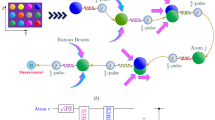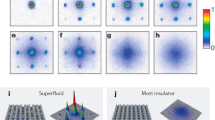Abstract
A brief survey of present-day achievements in quantum informatics is presented. Advantages of quantum computers are shown by an example of simplest quantum algorithms. Application of ultracold atoms for the implementation of quantum processors is considered.



Similar content being viewed by others
REFERENCES
F. Arute, K. Arya, R. Babbush, et al., ‘‘Quantum supremacy using a programmable superconducting processor,’’ Nature 574, 505–510 (2019). https://doi.org/10.1038/s41586-019-1666-5
IBM Quantum Experience. https://www.ibm.com/quantum-computing/. Cited June 29, 2020.
Yu. I. Manin, Computable and Uncomputable (Sovetskoye Radio, Moscow, 1980).
R. P. Feynman, ‘‘Simulating physics with computers,’’ Int. J. Theor. Phys. 21, 467–488 (1982). https://doi.org/10.1007/BF02650179
P. W. Shor, ‘‘Algorithms for quantum computation: discrete logarithms and factoring,’’ in Proc. 35th Annu. Symp. Foundations of Computer Science (SFCS 94), Washington, 1994 (IEEE Computer Society, Washington, 1994), p. 124. https://doi.org/10.1109/SFCS.1994.365700
M. A. Nielsen and I. Chuang, Quantum Computation and Quantum Information (Cambridge Univ. Press, New York, 2000).
A. Einstein, B. Podolsky, and N. Rosen, ‘‘Can quantum-mechanical description of physical reality be considered complete?,’’ Phys. Rev. 47, 777–780 (1935). https://doi.org/10.1103/PhysRev.47.777
D. Deutsch, ‘‘Quantum theory, the Church–Turing principle and the universal quantum computer,’’ Proc. R. Soc. Lond. A. 400 (1818), 97–117 (1985). https://doi.org/10.1098/rspa.1985.0070
I. N. Ashkarin, I. I. Beterov, D. B. Tretyakov, V. M. Entin, E. A. Yakshina, and I. I. Ryabtsev, ‘‘Scheme of a hydrogen-molecule quantum simulator based on two ultracold rubidium atoms,’’ Quantum Electron. 49, 449–454 (2019). https://doi.org/10.1070/QEL17002
D. P. DiVincenzo, ‘‘Quantum computation,’’ Science 270, 255–261 (1995). https://doi.org/10.1126/science.270.5234.255
R. Barends, C. M. Quintana, A. G. Petukhov, et al., ‘‘Diabatic gates for frequency-tunable superconducting qubits,’’ Phys. Rev. Lett. 123, 210501 (2019). https://doi.org/10.1103/PhysRevLett.123.210501
J. P. Gaebler, T. R. Tan, Y. Lin, Y. Wan, R. Bowler, A. C. Keith, S. Glancy, K. Coakley, E. Knill, D. Leibfried, and D. J. Wineland, ‘‘High-fidelity universal gate set for 9Be+ ion qubits,’’ Phys. Rev. Lett. 117, 060505 (2016). https://doi.org/10.1103/PhysRevLett.117.060505
D. Jaksh, J. I. Cirac, P. Zoller, S. L. Rolston, R. Côté, and M. D. Lukin, ‘‘Fast quantum gates for neutral atoms,’’ Phys. Rev. Lett. 85, 2208–2211 (2000). https://doi.org/10.1103/PhysRevLett.85.2208
S. Chu, J. E. Bjorkholm, A. Ashkin, and A. Cable, ‘‘Experimental observation of optically trapped atoms,’’ Phys. Rev. Lett. 57, 314–317 (1986). https://doi.org/10.1103/PhysRevLett.57.314
R. Grimm, M. Weidemüller, and Yu. B. Ovchinnikov, ‘‘Optical dipole traps for neutral atoms,’’ Adv. At., Mol., Opt. Phys. 42, 95–170 (2000). https://doi.org/10.1016/S1049-250X(08)60186-X
F. Nogrette, H. Labuhn, S. Ravets, D. Barredo, L. Béguin, A. Vernier, T. Lahaye, and A. Browaeys, ‘‘Single-atom trapping in holographic 2D arrays of microtraps with arbitrary geometries,’’ Phys. Rev. X 4, 021034 (2014). https://doi.org/10.1103/PhysRevX.4.021034
M. Schlosser, S. Tichelmann, J. Kruse, and G. Birkl, ‘‘Scalable architecture for quantum information processing with atoms in optical micro-structures,’’ Quantum Inf. Process. 10, 907–924 (2011). https://doi.org/10.1007/s11128-011-0297-z
Y. Wang, S. Shevate, T. M. Wintermantel, M. Morgado, G. Lochead, and S. Whitlock, ‘‘Preparation of hundreds of microscopic atomic ensembles in optical tweezer arrays,’’ npj Quantum Inf. 6, 54 (2020). https://doi.org/10.1038/s41534-020-0285-1
C. J. Picken, R. Legaie, and J. D. Pritchard, ‘‘Single atom imaging with an sCMOS camera,’’ Appl. Phys. Lett. 111, 164102 (2017). https://doi.org/10.1063/1.5003304
N. Schlosser, G. Reymond, and P. Grangier, ‘‘Collisional blockade in microscopic optical dipole traps,’’ Phys. Rev. Lett. 89, 023005 (2002). https://doi.org/10.1103/PhysRevLett.89.023005
D. Barredo, S. de Léséleuc, V. Lienhard, Th. Lahaye, and A. Browaeys, ‘‘An atom-by-atom assembler of defect-free arbitrary 2d atomic arrays,’’ Science 354, 1021–1023 (2016). https://doi.org/10.1126/science.aah3778
S. R. Samoylenko, A. V. Lisitsin, D. Schepanovich, I. B. Bobrov, S. S. Straupe, and S. P. Kulik, ‘‘Single atom movement with dynamic holographic optical tweezers,’’ Laser Phys. Lett. 17, 025203 (2020). https://doi.org/10.1088/1612-202X/ab6729
T. M. Graham, M. Kwon, B. Grinkemeyer, Z. Marra, X. Jiang, M. T. Lichtman, Y. Sun, M. Ebert, and M. Saffman, ‘‘Rydberg-mediated entanglement in a two-dimensional neutral atom qubit array,’’ Phys. Rev. Lett. 123, 230501 (2019). https://doi.org/10.1103/PhysRevLett.123.230501
M. Saffman, T. G. Walker, and K. Mølmer, ‘‘Quantum information with Rydberg atoms,’’ Rev. Mod. Phys. 82, 2313–2363 (2010).
M. Saffman, ‘‘Quantum computing with atomic qubits and Rydberg interactions: progress and challenges,’’ J. Phys. B: At., Mol. Opt. Phys. 49, 202001 (2016). https://doi.org/10.1088/0953-4075/49/20/202001
L. Henriet, L. Beguin, A. Signoles, Th. Lahaye, A. Browaeys, G.-O. Reymond, and Ch. Jurczak, ‘‘Quantum computing with neutral atoms,’’ Quant. Phys. Cornell Univers., 2020. arXiv:2006.12326 [quant-ph]
I. I. Ryabtsev, I. I. Beterov, D. B. Tret’yakov, V. M. Èntin, and E. A. Yakshina, ‘‘Spectroscopy of cold rubidium Rydberg atoms for applications in quantum information,’’ Phys.-Usp. 59, 196–208 (2016). https://doi.org/10.3367/UFNe.0186.201602k.0206
L. Isenhower, E. Urban, X. L. Zhang, A. T. Gill, T. Henage, T. A. Johnson, T. G. Walker, and M. Saffman, ‘‘Demonstration of a neutral atom controlled-NOT quantum gate,’’ Phys. Rev. Lett. 104, 010503 (2010). https://doi.org/10.1103/PhysRevLett.104.010503
T. F. Gallagher, Rydberg Atoms (Cambridge Univ. Press, Cambridge, 1994). https://doi.org/10.1017/CBO9780511524530
M. D. Lukin, M. Fleischhauer, R. Cote, L. M. Duan, D. Jaksch, J. I. Cirac, and P. Zoller, ‘‘Dipole blockade and quantum information processing in mesoscopic atomic ensembles,’’ Phys. Rev. Lett. 87, 03790 (2001). https://doi.org/10.1103/PhysRevLett.87.037901
H. Levine, A. Keesling, G. Semeghini, A. Omran, T. T. Wang, S. Ebadi, H. Bernien, M. Greiner, V. Vuletić, H. Pichler, and M. D. Lukin, ‘‘Parallel implementation of high-fidelity multiqubit gates with neutral atoms,’’ Phys. Rev. Lett. 123, 170503 (2019). https://doi.org/10.1103/PhysRevLett.123.170503
I. I. Beterov, E. A. Yakshina, D. B. Tretyakov, V. M. Entin, U. Singh, Ya. V. Kudlaev, K. Yu. Mityanin, K. A. Panov, N. V. Al’yanova, and I. I. Ryabtsev, ‘‘Trapping and detection of single rubidium atoms in an optical dipole trap using a long-focus objective lens,’’ Quantum Electron. 50, 543–550 (2020). https://doi.org/10.1070/QEL17336
I. I. Beterov, M. Saffman, E. A. Yakshina, D. B. Tretyakov, V. M. Entin, S. Bergamini, E. A. Kuznetsova, and I. I. Ryabtsev, ‘‘Two-qubit gates using adiabatic passage of the stark-tuned Förster resonances in Rydberg atoms,’’ Phys. Rev. A 94, 062307 (2016). https://doi.org/10.1103/PhysRevA.94.062307
I. I. Beterov, G. N. Hamzina, E. A. Yakshina, D. B. Tretyakov, V. M. Entin, and I. I. Ryabtsev, ‘‘Adiabatic passage of radio-frequency-assisted Förster resonances in Rydberg atoms for two-qubit gates and the generation of Bell states,’’ Phys. Rev. A 97, 032701 (2018). https://doi.org/10.1103/PhysRevA.97.032701
I. I. Beterov, G. N. Khamzina, D. B. Tret’yakov, V. M. Entin, E. A. Yakshina, and I. I. Ryabtsev, ‘‘Resonant dipole–dipole interaction of Rydberg atoms for realisation of quantum computations,’’ Quantum Electron. 48, 453–459 (2018). https://doi.org/10.1070/QEL16663
I. I. Beterov, M. Saffman, E. A. Yakshina, V. P. Zhukov, D. B. Tretyakov, V. M. Entin, I. I. Ryabtsev, C. W. Mansell, C. MacCormick, S. Bergamini, and M. P. Fedoruk, ‘‘Quantum gates in mesoscopic atomic ensembles based on adiabatic passage and Rydberg blockade,’’ Phys. Rev. A 88, 010303 (2013). https://doi.org/10.1103/PhysRevA.88.010303
I. I. Beterov, M. Saffman, V. P. Zhukov, D. B. Tretyakov, V. M. Entin, E. A. Yakshina, I. I. Ryabtsev, C. W. Mansell, C. MacCormick, S. Bergamini, and M. P. Fedoruk, ‘‘Coherent control of mesoscopic atomic ensembles for quantum information,’’ Laser Phys. 24, 074013 (2014). https://doi.org/10.1088/1054-660X/24/7/074013
D. B. Tretyakov, I. I. Beterov, E. A. Yakshina, V. M. Entin, I. I. Ryabtsev, P. Cheinet, and P. Pillet, ‘‘Observation of the Borromean three-body Förster resonances for three interacting Rb Rydberg atoms,’’ Phys. Rev. Lett. 119, 173402 (2017). https://doi.org/10.1103/PhysRevLett.119.173402
I. I. Beterov, M. Saffman, E. A. Yakshina, D. B. Tretyakov, V. M. Entin, G. N. Hamzina, and I. I. Ryab- tsev, ‘‘Simulated quantum process tomography of quantum gates with Rydberg superatoms,’’ J. Phys. B. 49, 114007 (2016). https://doi.org/10.1088/0953-4075/49/11/114007
I. I. Beterov, I. N. Ashkarin, E. A. Yakshina, D. B. Tretyakov, V. M. Entin, I. I. Ryabtsev, P. Cheinet, P. Pillet, and M. Saffman, ‘‘Fast three-qubit Toffoli quantum gate based on three-body Förster resonances in Rydberg atoms,’’ Phys. Rev. A. 98, 042704 (2018). https://doi.org/10.1103/PhysRevA.98.042704
Funding
This work was supported by the Russian Foundation for Basic Research (project no. 19-52-15010) [the survey of quantum computation principles] and Russian Science Foundation (project no. 18-12-00313) [the survey of physical platforms for the implementation of quantum computers].
Author information
Authors and Affiliations
Corresponding author
Additional information
#Papers of this section are devoted to the anniversary of the Optical Information Technology Department, Novosibirsk State Technical University.
About this article
Cite this article
Beterov, I. Quantum Computers Based on Cold Atoms\({}^{\mathbf{\#}}\) . Optoelectron.Instrument.Proc. 56, 317–324 (2020). https://doi.org/10.3103/S8756699020040020
Received:
Revised:
Accepted:
Published:
Issue Date:
DOI: https://doi.org/10.3103/S8756699020040020




